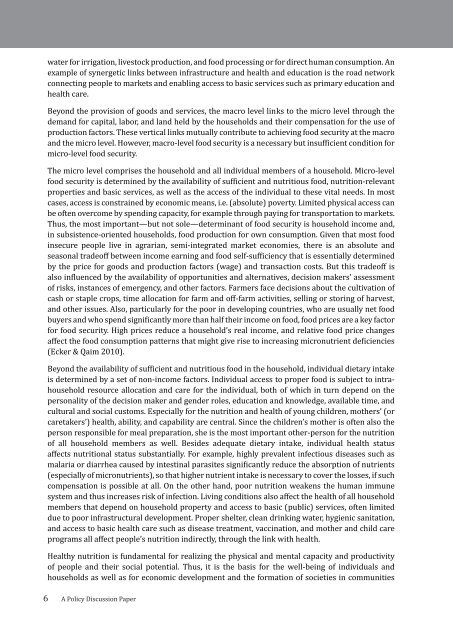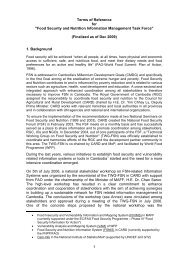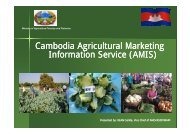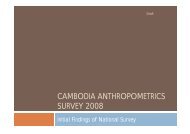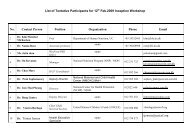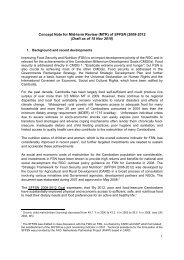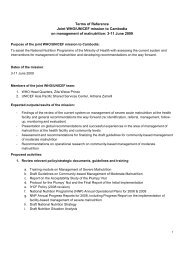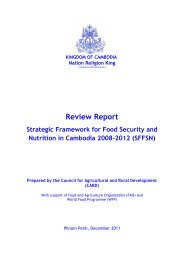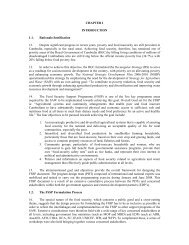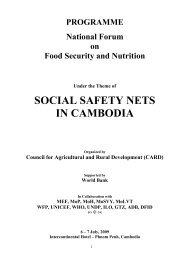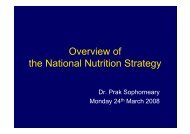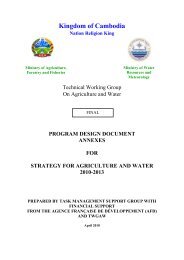Food Security and Nutrition in Cambodia: Pattern and ... - CDRI
Food Security and Nutrition in Cambodia: Pattern and ... - CDRI
Food Security and Nutrition in Cambodia: Pattern and ... - CDRI
Create successful ePaper yourself
Turn your PDF publications into a flip-book with our unique Google optimized e-Paper software.
water for irrigation, livestock production, <strong>and</strong> food process<strong>in</strong>g or for direct human consumption. An<br />
example of synergetic l<strong>in</strong>ks between <strong>in</strong>frastructure <strong>and</strong> health <strong>and</strong> education is the road network<br />
connect<strong>in</strong>g people to markets <strong>and</strong> enabl<strong>in</strong>g access to basic services such as primary education <strong>and</strong><br />
health care.<br />
Beyond the provision of goods <strong>and</strong> services, the macro level l<strong>in</strong>ks to the micro level through the<br />
dem<strong>and</strong> for capital, labor, <strong>and</strong> l<strong>and</strong> held by the households <strong>and</strong> their compensation for the use of<br />
production factors. These vertical l<strong>in</strong>ks mutually contribute to achiev<strong>in</strong>g food security at the macro<br />
<strong>and</strong> the micro level. However, macro-level food security is a necessary but <strong>in</strong>sufficient condition for<br />
micro-level food security.<br />
The micro level comprises the household <strong>and</strong> all <strong>in</strong>dividual members of a household. Micro-level<br />
food security is determ<strong>in</strong>ed by the availability of sufficient <strong>and</strong> nutritious food, nutrition-relevant<br />
properties <strong>and</strong> basic services, as well as the access of the <strong>in</strong>dividual to these vital needs. In most<br />
cases, access is constra<strong>in</strong>ed by economic means, i.e. (absolute) poverty. Limited physical access can<br />
be often overcome by spend<strong>in</strong>g capacity, for example through pay<strong>in</strong>g for transportation to markets.<br />
Thus, the most important—but not sole—determ<strong>in</strong>ant of food security is household <strong>in</strong>come <strong>and</strong>,<br />
<strong>in</strong> subsistence-oriented households, food production for own consumption. Given that most food<br />
<strong>in</strong>secure people live <strong>in</strong> agrarian, semi-<strong>in</strong>tegrated market economies, there is an absolute <strong>and</strong><br />
seasonal tradeoff between <strong>in</strong>come earn<strong>in</strong>g <strong>and</strong> food self-sufficiency that is essentially determ<strong>in</strong>ed<br />
by the price for goods <strong>and</strong> production factors (wage) <strong>and</strong> transaction costs. But this tradeoff is<br />
also <strong>in</strong>fluenced by the availability of opportunities <strong>and</strong> alternatives, decision makers’ assessment<br />
of risks, <strong>in</strong>stances of emergency, <strong>and</strong> other factors. Farmers face decisions about the cultivation of<br />
cash or staple crops, time allocation for farm <strong>and</strong> off-farm activities, sell<strong>in</strong>g or stor<strong>in</strong>g of harvest,<br />
<strong>and</strong> other issues. Also, particularly for the poor <strong>in</strong> develop<strong>in</strong>g countries, who are usually net food<br />
buyers <strong>and</strong> who spend significantly more than half their <strong>in</strong>come on food, food prices are a key factor<br />
for food security. High prices reduce a household’s real <strong>in</strong>come, <strong>and</strong> relative food price changes<br />
affect the food consumption patterns that might give rise to <strong>in</strong>creas<strong>in</strong>g micronutrient deficiencies<br />
(Ecker & Qaim 2010).<br />
Beyond the availability of sufficient <strong>and</strong> nutritious food <strong>in</strong> the household, <strong>in</strong>dividual dietary <strong>in</strong>take<br />
is determ<strong>in</strong>ed by a set of non-<strong>in</strong>come factors. Individual access to proper food is subject to <strong>in</strong>trahousehold<br />
resource allocation <strong>and</strong> care for the <strong>in</strong>dividual, both of which <strong>in</strong> turn depend on the<br />
personality of the decision maker <strong>and</strong> gender roles, education <strong>and</strong> knowledge, available time, <strong>and</strong><br />
cultural <strong>and</strong> social customs. Especially for the nutrition <strong>and</strong> health of young children, mothers’ (or<br />
caretakers’) health, ability, <strong>and</strong> capability are central. S<strong>in</strong>ce the children’s mother is often also the<br />
person responsible for meal preparation, she is the most important other-person for the nutrition<br />
of all household members as well. Besides adequate dietary <strong>in</strong>take, <strong>in</strong>dividual health status<br />
affects nutritional status substantially. For example, highly prevalent <strong>in</strong>fectious diseases such as<br />
malaria or diarrhea caused by <strong>in</strong>test<strong>in</strong>al parasites significantly reduce the absorption of nutrients<br />
(especially of micronutrients), so that higher nutrient <strong>in</strong>take is necessary to cover the losses, if such<br />
compensation is possible at all. On the other h<strong>and</strong>, poor nutrition weakens the human immune<br />
system <strong>and</strong> thus <strong>in</strong>creases risk of <strong>in</strong>fection. Liv<strong>in</strong>g conditions also affect the health of all household<br />
members that depend on household property <strong>and</strong> access to basic (public) services, often limited<br />
due to poor <strong>in</strong>frastructural development. Proper shelter, clean dr<strong>in</strong>k<strong>in</strong>g water, hygienic sanitation,<br />
<strong>and</strong> access to basic health care such as disease treatment, vacc<strong>in</strong>ation, <strong>and</strong> mother <strong>and</strong> child care<br />
programs all affect people’s nutrition <strong>in</strong>directly, through the l<strong>in</strong>k with health.<br />
Healthy nutrition is fundamental for realiz<strong>in</strong>g the physical <strong>and</strong> mental capacity <strong>and</strong> productivity<br />
of people <strong>and</strong> their social potential. Thus, it is the basis for the well-be<strong>in</strong>g of <strong>in</strong>dividuals <strong>and</strong><br />
households as well as for economic development <strong>and</strong> the formation of societies <strong>in</strong> communities<br />
6 A Policy Discussion Paper


